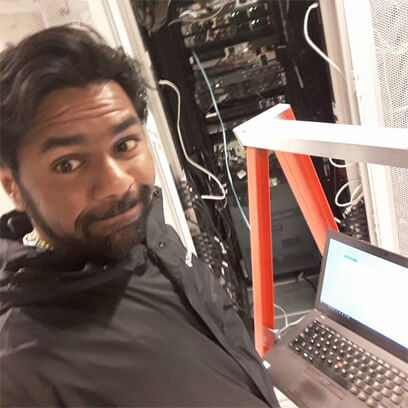CloudLamb E-Learning

F5 Advanced Web Application Firewall (WAF) - ASM 303
Instructor del curso

Joeronimo Yoel Enciso Saravia
None
Clases en tiempo real
Para nuestras conferencias en vivo utilizamos las siguientes herramientas, las cuales te permitirán interactuar de manera directa con tu mentor y demás compañeros de clase.

No pierdas la oportunidad de:
- Aclarar las dudas en tiempo real
- Acceder al contenido teórico/práctico por tiempo ilimitado
- Evaluaciones
- Proyectos
- Laboratorios y casos de estudios prácticos
¿De qué trata esta carrera?
¿Estás listo para aprender las habilidades técnicas de las soluciones F5?
Aprende las políticas básicas de seguridad de aplicaciones web
Hoy en día es muy importante proteger la red de los sistemas automáticos y las vulnerabilidades por ello este curso permite identificar y mitigar las vulnerabilidades comunes de las aplicaciones web del lado del cliente y de la aplicación del espectro de amenazas
La capacitación WAF F5 contempla el estudio y la preparación para el examen de certificación BIG-IP ASM 303, F5 Advanced Web Application Firewall (WAF) lo cual una vez culminado se valida que el participante tiene las habilidades, la comprensión y el conocimiento especializado de las soluciones F5, lo que le permite contribuir de manera más efectiva a las soluciones F5.
¿Qué aprenderás?
Aprenderás cómo implementar, ajustar y operar BIG IP Advance Web Aplication Firewall (WAF) para proteger sus aplicaciones web de ataques basados en HTTP.
A través de una combinación de laboratorios teóricos/ prácticos y conferencias interactivas, aprenderás cómo se utilizan los diferentes componentes de WAF para detectar y mitigar amenazas de múltiples vectores de ataque, como:
Los participantes obtendrán un nivel funcional de experiencia con F5 Web Application Firewall, incluida la política de seguridad integral y la configuración del perfil, la evaluación del cliente y los tipos de mitigación apropiados.
¿Hacia quién va dirigido?
Este curso está dirigido a los administradores de seguridad y de red que serán responsables de implementar el F5 Advanced Web Application Firewall para proteger las aplicaciones web de las vulnerabilidades comunes y de la denegación de servicio.
Requisitos
Es recomendable que su laptop y/o computadora, cuente con los siguientes recursos para tener un ambiente de laboratorio acorde a las prácticas del curso:
- CPU 64-bit architectur
- AMD CPU that has AMD-V suppoty
- 2.0GHz cores, and the VE is set to 4 cores, you will need 4x2.0GHz reserved for 8GHz
Calendario del curso
Duración:
Desde el 4 de Septiembre de 2025
hasta el 11 de Octubre de 2025
Duración en semanas: 6
Duración en horas: 24
Modalidad:
100% online con
instructores en vivo
Certificado digital emitido por CloudLamb E-learning:
Sí
Cierre de las inscripciones:
4 de Septiembre de 2025
Horario semanal:
Jueves, Sábados
| Día | Hora | País |
|---|---|---|
| Jueves | De 20:00 hrs a 22:00 hrs |

|
| Sábados | De 10:00 hrs a 12:00 hrs |

|

Formas de pago
F5 Advanced Web Application Firewall (WAF) - ASM 303

Paga con tu tarjeta de crédito

Transferencia nacional
 Pago Único
Pago Único
 Pago por cuotas
Pago por cuotas
 Contáctanos
Contáctanos
Aviso importante
* Al realizar una compra, está aceptando nuestros términos y condiciones
* El curso iniciará al completarse el mínimo de participantes requerido
* Precios sujetos a cambios según el curso
Nota importante
Pago único:
- Si no te has registrado en CloudLamb debes hacer clic en el siguiente enlace.
- Si te encuentras registrad@ debes iniciar sesión haciendo clic en el siguiente enlace.
- Una vez logued@ en CloudLamb podrás realizar tu pago en la sección Formas de pago > Pago único.
- Al formalizar a través de cuenta Paypal, recibirás la notificación a tu correo electrónico y quedarás inscrit@ en el curso, lo cual podrás visualizar en el siguiente enlace.
- Si la inscripción es otro medio de pago debe notificarlo al correo corporativo info@cloud-lamb.com.
Pago por cuotas:
- Si no te has registrado en CloudLamb debes hacer clic en el siguiente enlace.
- Si te encuentras registrad@ debes iniciar sesión haciendo clic en el siguiente enlace.
- Hacer clic en el botón Comprar por cuotas en la sección Formas de pago del curso correspondiente.
- En el menú de estudiante ubicado en la parte superior derecha ir al ítem Mis cuotas y desde allí tendrás tu sistema de cuotas.
- Al formalizar a través de cuenta Paypal, recibirás la notificación a tu correo electrónico y quedarás inscrit@ en el curso.
- Si la inscripción es otro medio de pago debe notificarlo al correo corporativo info@cloud-lamb.com.
Certificado modelo


Inscríbete aquí
¡Ahora sí! estamos preparados para comenzar este grandioso proceso que nos llevará a la preparación profesional que necesitamos.
Instructores de 














